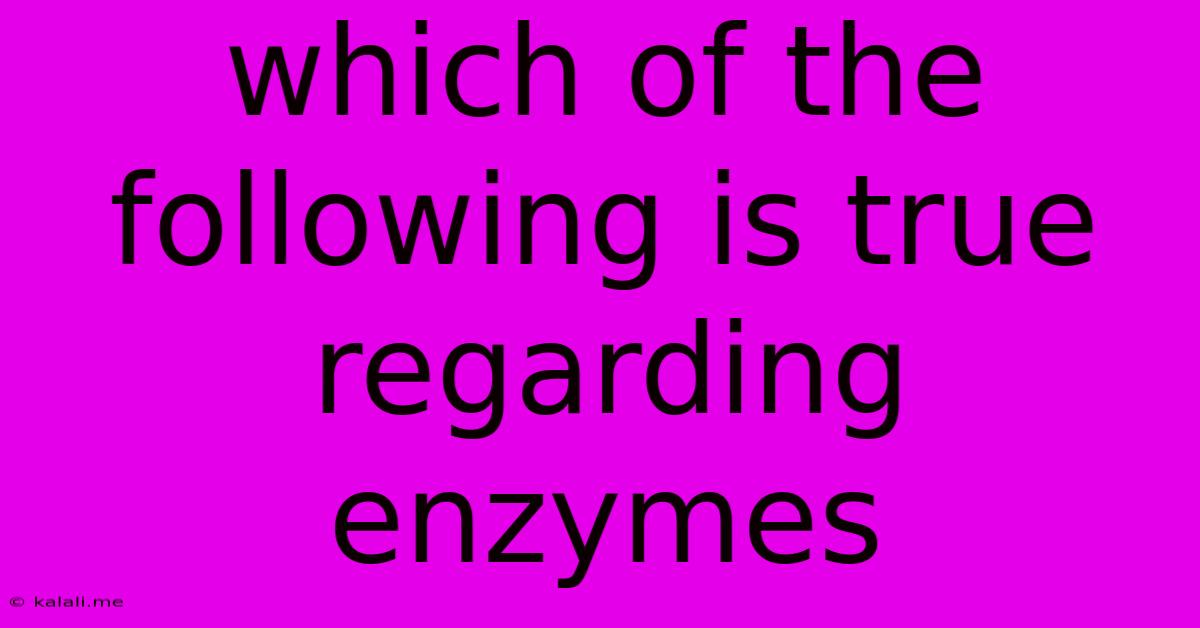Which Of The Following Is True Regarding Enzymes
Kalali
Jun 14, 2025 · 3 min read

Table of Contents
Which of the Following is True Regarding Enzymes? A Deep Dive into Enzyme Function
Enzymes are biological catalysts that significantly speed up the rate of virtually all chemical reactions within cells. Understanding their properties is crucial in various fields, from medicine to biotechnology. This article explores the fundamental truths about enzymes, clarifying common misconceptions and providing a comprehensive overview of their essential characteristics. We'll delve into their specificity, regulation, and overall importance in biological processes.
What are Enzymes?
Enzymes are typically proteins (although some catalytic RNA molecules also exist, known as ribozymes). Their remarkable ability to accelerate reactions stems from their unique three-dimensional structures, which create an active site. This active site is a specific region where substrate molecules bind, initiating the catalytic process. The enzyme-substrate complex formed is crucial for the reaction to occur efficiently. This process is highly specific, meaning enzymes only catalyze particular reactions.
Key Characteristics of Enzymes:
Here's a breakdown of statements often associated with enzymes, clarifying which are true and explaining why:
-
Statement 1: Enzymes are highly specific in their action. TRUE. This is a cornerstone of enzyme function. The active site's unique shape and chemical properties ensure that only specific substrate molecules can bind and react. This specificity is essential for maintaining the precise control of biochemical pathways within the cell. Think of a lock and key – the substrate is the key, and the active site is the lock. Only the correct key (substrate) will fit and initiate the reaction.
-
Statement 2: Enzymes lower the activation energy of a reaction. TRUE. This is perhaps the most significant characteristic of enzymes. Activation energy is the energy required to initiate a chemical reaction. Enzymes dramatically reduce this energy barrier, allowing reactions to proceed much faster at lower temperatures than they would without enzymatic catalysis. They achieve this by stabilizing the transition state, the high-energy intermediate formed during the reaction.
-
Statement 3: Enzymes are consumed during the reaction. FALSE. Enzymes are not consumed during the reaction they catalyze. After the reaction is complete, the enzyme is released, unchanged, and free to catalyze the same reaction again with another substrate molecule. This makes them incredibly efficient catalysts, capable of catalyzing thousands or even millions of reactions per minute.
-
Statement 4: Enzyme activity is affected by temperature and pH. TRUE. Enzymes, being proteins, are sensitive to changes in their environment. Optimal temperature and pH values exist for each enzyme; deviations from these optima can lead to decreased activity or even irreversible denaturation (loss of three-dimensional structure and function). Extreme temperatures or pH values can disrupt the delicate balance of forces maintaining the enzyme's active site, rendering it inactive.
-
Statement 5: Enzyme activity can be regulated. TRUE. Enzyme activity is tightly regulated within cells to ensure that metabolic pathways function efficiently and are responsive to cellular needs. Regulation can occur through various mechanisms, including allosteric regulation (binding of a molecule to a site other than the active site), covalent modification (chemical modification of the enzyme), and feedback inhibition (a product of the pathway inhibits an earlier enzyme). This intricate regulation allows cells to maintain homeostasis and adapt to changing conditions.
Conclusion:
Understanding the properties of enzymes is fundamental to grasping the complexities of biological systems. Their specificity, ability to lower activation energy, and susceptibility to environmental factors are key aspects that determine their function and efficiency. The regulation of enzyme activity further highlights the intricate control mechanisms governing cellular processes. This knowledge underpins advances in various fields, from developing new drugs to engineering more efficient bioprocesses.
Latest Posts
Latest Posts
-
Square Root Of 42 In Radical Form
Jun 14, 2025
-
Select Every Kth Individual From The Population
Jun 14, 2025
-
How Many Hours Is A Hockey Game
Jun 14, 2025
-
Which Of The Following Statements About Minerals Is False
Jun 14, 2025
-
Put The Following Events In Chronological Order
Jun 14, 2025
Related Post
Thank you for visiting our website which covers about Which Of The Following Is True Regarding Enzymes . We hope the information provided has been useful to you. Feel free to contact us if you have any questions or need further assistance. See you next time and don't miss to bookmark.